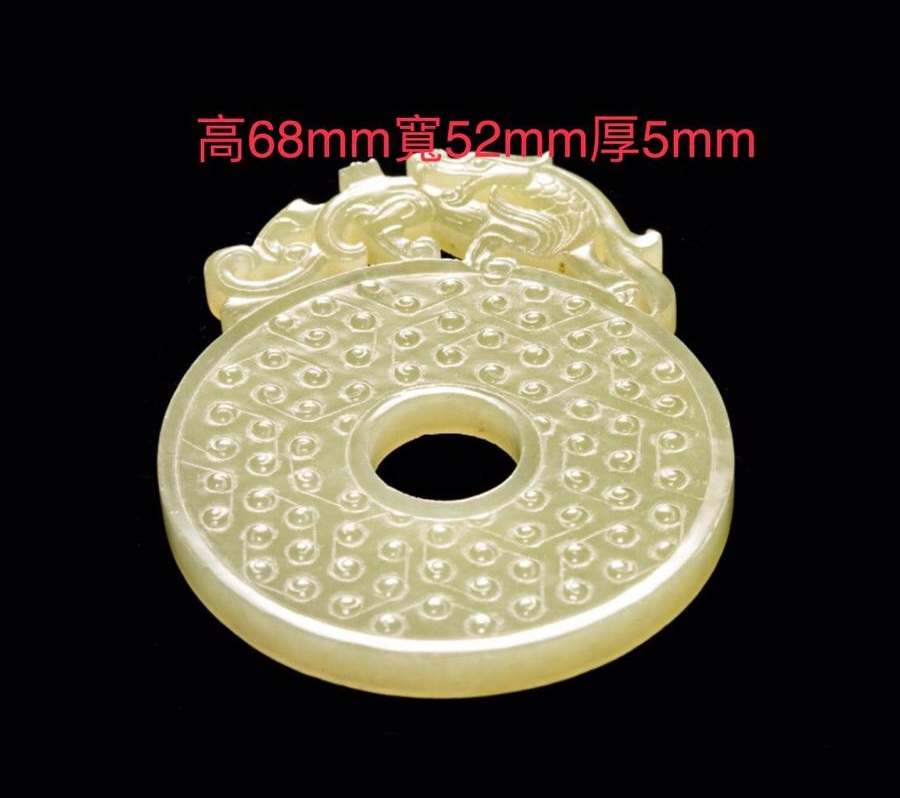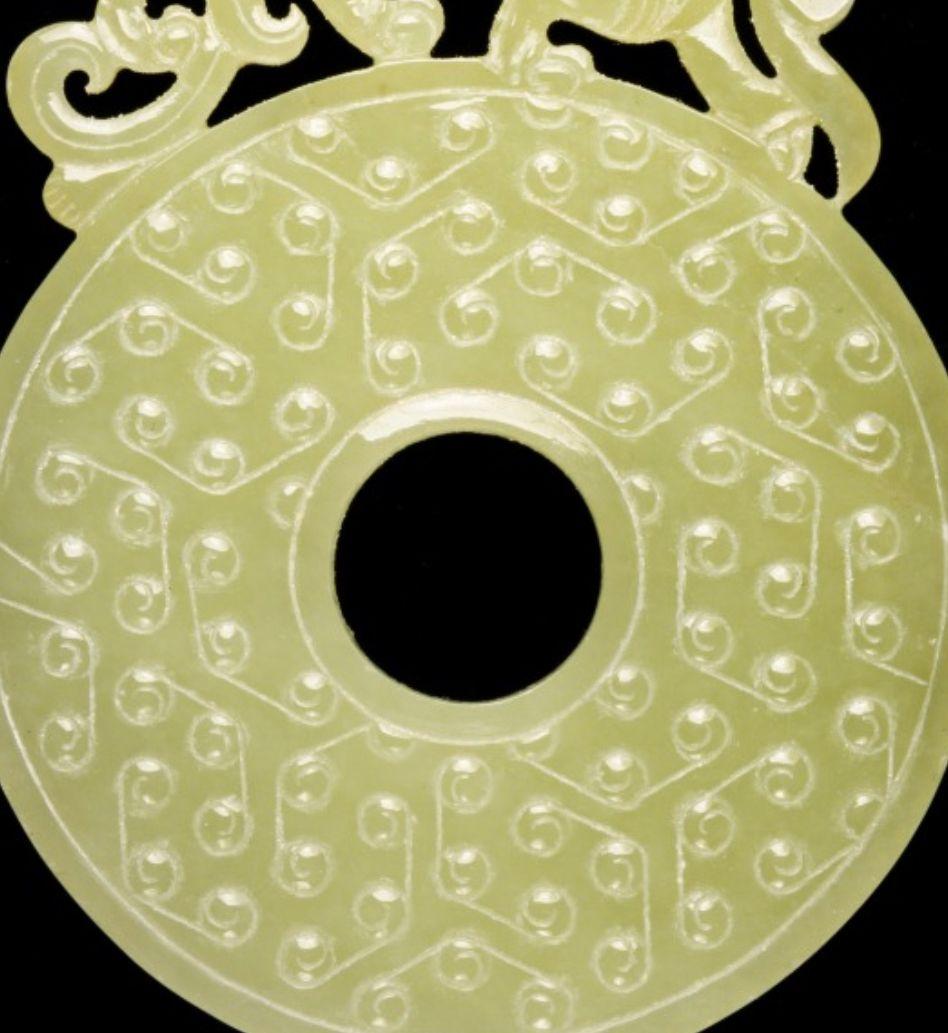Notes on Appreciating Ancient Jade
1. Foundational Understanding of Ancient Jade
(1) Color: The Symbol of Nature and Power
The hues of natural jade vary infinitely—each piece is a unique creation of nature. Owing to the differing mineral sources and craftsmanship across dynasties, the dominant colors of jade evolved distinctly over time. For instance, during the Western Han dynasty, “yellow jade” was exclusively reserved for the imperial family, forbidden to commoners, embodying supreme power and the divine mandate.
(2) Form: The Physical Expression of Dynastic Authority
The forms of ancient jade were not the result of artisans’ individual creativity, but rather symbolic designs defined by court ritual and cosmological beliefs. They served to manifest the political and cultural essence of their times. Exquisite jade pieces were often products of prosperous eras. Each dynasty developed distinct formal traits—for example, the Han dynasty favored “dragon and bi-disc” combinations, while the Spring and Autumn period is renowned for the hexagonal “fu-patterned bi” (decorated disc).
(3) Patterns: Encoded Symbols of the Era
The engraved patterns on jade carry profound cultural, religious, and hierarchical meaning, making them crucial for both aesthetic analysis and chronological identification. Particular attention should be paid to carving technique (incised vs. relief), distinctive structures (such as “que-ti” or “fei-leng” ridges), pattern repetition, and geometric arrangement. Each dynasty displayed recognizable stylistic features—for example, the Spring and Autumn period favored hexagonal “fu pattern” designs, while the Han dynasty’s dragon motifs commonly feature feathered wings and celestial associations with constellations.
2. Western Han Yellow Jade Dragon Bi: A Royal Manifestation of Cosmology


(1) Basic Information
-
Name: Western Han Yellow Jade Dragon Bi
-
Dimensions: Height 68 mm, width 52 mm, thickness 5 mm; disc outer diameter 52 mm, inner diameter 14 mm
-
Cultural Context: Deeply influenced by the cosmological thought of yin-yang and the Book of Changes (Yi Jing), this artifact reflects the ancient Chinese conception of the universe. Its composition aligns with the “Three Enclosures and Twenty-Eight Mansions” system—three celestial zones (Ziwei, Taiwei, Tianshi) and four directional constellations (Azure Dragon of the East, Vermilion Bird of the South, White Tiger of the West, and Black Tortoise of the North). The piece epitomizes the Han notion of “unity between heaven and humankind.”
(2) Indicators of Han Dynasty Origin
The chronological identification of this dragon bi can be deduced from multiple aspects:
-
Material: Crafted from yellow jade, reserved exclusively for the Han imperial court.
-
Form: A winged Azure Dragon poised upon a round bi-disc, embodying the Han cosmological idea of “Heaven as round, Earth as square.”
-
Patterns: The dragon’s body features nine scales, a symbol of imperial sovereignty; the triple W-shaped ridges (“three beams”) signify authority; taiji-style astral motifs correspond directly to the Three Enclosures and Twenty-Eight Mansions.
-
Craftsmanship: Lines are fluid and natural; the star-like boss motifs are executed in shallow relief—indicative of advanced Han-era carving techniques.
-
Proportion and Motion: Merely 5 mm thick, the structure is finely balanced with elegant proportions. The dragon turns its head backward with an open mouth, exuding vitality and tension.
-
Surface Condition: The jade exhibits natural aging, patina, and weathering marks consistent with an artifact of over two millennia.
(3) Cosmological Symbolism in Form
The piece consists of a circular bi-disc forming the base, surmounted by a dragon whose head turns gracefully backward. The central aperture of the disc symbolizes the Earth, while its outer ring represents the heavens. The dragon corresponds to the Eastern Azure Dragon, leader of the Four Symbols, embodying the cosmic order envisioned by the Han people.
(4) Dragon Motifs and Symbolic Vocabulary
| Ornament Name | Main Features | Symbolic Meaning |
|---|---|---|
| Almond-shaped Eyes | Raised rims above and below | Highlights divine majesty and authority |
| Feathered Wings | Incised lines curling upward | Symbol of the Azure Dragon constellation |
| Coiled Tail (with "Que Ti") | Twin tails, one long and one short, with triangular protrusion (“Que Ti”) below | Reinforces structural completeness and royal authority |
| Horns | Unequal horns, sharply raised upward | Represents divine nature and heavenly mandate |
| Mane | Flowing curves continuing from horns | Typical decorative element of Han dragon designs |
| Claws | Four toes in raised symmetry | Follows Han craftsmanship conventions for dragon claws |
| Scales | Nine alternating concave and convex scales | The number nine symbolizes the emperor and ultimate power |
| Tooth | Tadpole-shaped raised fang | Enhances the dragon’s dynamism and sacred aura |
| Ridge (Fei Leng) | W-shaped triple ridges along the back | Denotes hierarchical status, symbolic of ceremonial privilege |
(5) Symbolism of the Bi-disc Component
-
Central Aperture: Represents the core of the Earth.
-
Inclined Edges: The alternating inner and outer slopes divide the circle into six equal parts (each 60°), echoing celestial movement.
-
Taiji Star Patterns: The raised boss motifs, connected by arc-shaped incised lines, form yin-yang spirals; groups of three represent the “Three Enclosures,” with a total of twenty-eight sets symbolizing the “Twenty-Eight Mansions.” These embody the Han aspiration to express the cosmic order through numerical harmony.
3. Spring and Autumn Fu-patterned Bi: The Geometry of Order
(1) Basic Information
-
Name: Fu-patterned Bi, Spring and Autumn Period
-
Distinctive Traits: Decorated with raised “fu” hexagonal motifs characterized by clarity, symmetry, and balance.
-

(2) Identification Features
Each raised unit is neatly hexagonal—an unmistakable hallmark of jades from this era. The smooth lines and uniform angles reveal the aesthetic emphasis on geometric discipline and structural order distinctive to the Spring and Autumn artisans.
4. Cultural Continuity and Symbolism: The Ming Crystal Seven-Beam Crown
The renowned Ming dynasty artifact “Seven-Beam Crystal Crown” is made of translucent white crystal, carved with seven ridged beams in a double-layered, cloud-like form, with a perforation beneath for fastening. Culturally, both “beam” and “crown” signify the connection between heaven and man, as well as hierarchical distinction. In ancient ritual texts, the architectural ceremony of “raising the beam” was likened to “a man’s capping ceremony,” reflecting a shared cosmological symbolism. This parallels the representation of “beams” in ancient jade, which denoted authority and cosmic alignment.

5. Core Steps in Jade Appreciation
-
Observe the Whole: Begin with size, color, and form to grasp the general era and rank of the artifact.
-
Examine Details: Focus on craftsmanship (incised vs. relief carving) and unique structures (such as que-ti and fei-leng); these are crucial for dating and authentication.
-
Decode the Symbols: Integrate numerical, material, and cultural elements—nine and five symbolize imperial authority, the 60° division implies cosmic cycles, yellow jade denotes royal power, and motifs reflect yin-yang and star constellations.
-
Compare Across Eras: Identify distinctive features of each period, such as dragon-and-constellation motifs of the Han or the hexagonal fu patterns of the Spring and Autumn period.
6. Core Logic of Jade Authentication
(1) Genuine “Period” Jade
Authentic jade from its proper era displays exceptional coherence—proportion, carving, and material all align seamlessly. The impression is natural, refined, and unmistakably correct.
(2) Authentication Principle
In jade evaluation, the principle is simple: “If one aspect is genuine, the entire piece is genuine; if one flaw appears, the entire piece is likely not of the period.” Discovering a single inconsistency often indicates a 90% probability of a later imitation.
(3) Example: Hooked Lotus and Boss-Patterned Cup
A jade cup carved with hooked lotus buds appears reddish in hue, with soft texture suggesting Xiuyan jade. The red coloration often results from insufficient hardness and is typical of later materials. Hence, it is likely a post-Han imitation rather than an original period artifact.
(4) Features of Authentic Period Jade
Authentic ancient jade exhibits a lucid, three-dimensional quality. The craftsmanship is lively and precise, the forms crisp and well-defined, and carving techniques refined—qualities that later reproductions rarely achieve.

